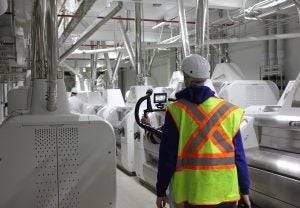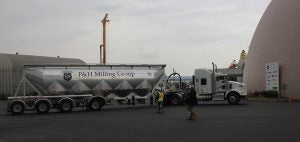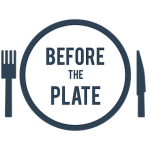Our 29th day of shooting brought us to the end of the journey of yet another ingredient, wheat. We have been following wheat from an organic farm, that fits into the larger category, relatively speaking, with about 800 acres of cropland. Challenging what many people in the urban areas may think of as an organic farm, there are some big pieces of equipment that are used to grow their crops, and the level of sophistication is impressive. The general idea of conflating organic and small scale together is not always the case. That said, for consumers, the size of the farm should really be the least of their worries — high level of care for the environment, food safety, and quality products should be the priority no matter which method of farming is being practiced.
Our farmer featured in the documentary sold his wheat to a large grain handling company who does their own milling and storage. We visited one of their many facilities in Canada to see what went into milling flour that would later be used in our dish. The size and scale of the operation we filmed was truly breathtaking.

After clearing MARSEC level 1 security, we drove up to the plant. As we turned the corner, we saw a large ship being off-loaded in the harbor that was carrying wheat from the prairies in western Canada. It has been transported by rail and then transferred onto a ship to be taken across the Great Lakes. They also had their own rail line going into the port with train cars filled to the brim with grain as well as a line of semi trucks waiting to be off loaded. To say this was a large operation would be an understatement. During our tour, we were given the rundown of the numbers, which confirmed that scale of the operation. Grain was being transferred off of and onto the ship at a rate of about 1.7 million pounds per hour. The flour mill was then taking much of the wheat being brought in and was milling the wheat into flour at a rate of about 44,000 pounds per hour. The flour is then sifted, at which point it can be bagged or loaded directly into tanker trucks. The tankers carry roughly 35,000 pounds of flour and the largest industrial bakeries take up to seven trucks per day.

On all of the shoots we do, there is at least one moment when this amazing feeling of wholeness happens. Its when the crew looks around and realizes we all fit into this system. Operations that are large or small, old or new. Each ingredient takes its own unique journey, but to see it all come together and end up in a form we all know and recognize as food is an amazing experience.
If we take away all the complexity, that is the goal for “Before The Plate.” We want people to feel as if they are part of the journey of their food by taking a single plate of food and following all the ingredients back to the farms they came from. We want people to understand the process from start to finish. Once that happens, then the urban population can start asking the right questions about their food system. Any good person should be concerned about what they eat. The question then becomes, in a world of overwhelming labels and claims, how can the everyday consumer make the best decision for themselves and their family. We think the answer is to bring them on the journey.
To connect with “Before The Plate’s” journey, follow them on Facebook and on Instagram and stay tuned to AGDAILY.com. Click here to donate to “Before the Plate.”



